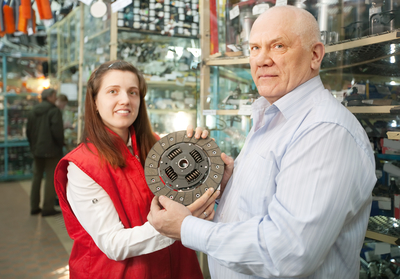 There’s no denying that recent supply-chain disruptions are putting a two-fold crunch on many aftermarket sellers. On one hand, consumer demand for aftermarket products is surging as enthusiasts turn to do-it-yourself automotive projects to while away the hours of COVID-19-induced shutdowns. On the other, scarcity of raw materials, temporary closures or slowdowns of industrial facilities and even hoarding of key items have hindered the ability of brands to speed enough product to warehouse distributors (WDs) and retailers to meet market needs.
There’s no denying that recent supply-chain disruptions are putting a two-fold crunch on many aftermarket sellers. On one hand, consumer demand for aftermarket products is surging as enthusiasts turn to do-it-yourself automotive projects to while away the hours of COVID-19-induced shutdowns. On the other, scarcity of raw materials, temporary closures or slowdowns of industrial facilities and even hoarding of key items have hindered the ability of brands to speed enough product to warehouse distributors (WDs) and retailers to meet market needs.
 Founded and owned by Chris Gabrelcik, Lubrication Specialties (also known as Hot Shot’s Secret) manufactures industrial-grade lubricants and additives designed to improve engine performance in both professional and everyday consumer applications. Located in Mt. Gilead, Ohio, just north of Columbus, the company has outgrown three buildings in the past eight years and now is headquartered in a 30,000-sq.-ft. production warehouse set to double in size in the coming year.
Founded and owned by Chris Gabrelcik, Lubrication Specialties (also known as Hot Shot’s Secret) manufactures industrial-grade lubricants and additives designed to improve engine performance in both professional and everyday consumer applications. Located in Mt. Gilead, Ohio, just north of Columbus, the company has outgrown three buildings in the past eight years and now is headquartered in a 30,000-sq.-ft. production warehouse set to double in size in the coming year.
 As retail businesses reopen across the country and customers gradually return to stores, companies are rolling out new policies to adapt to the “new normal” business climate afforded by the COVID-19 coronavirus pandemic. Foremost among those are new protocols for workplace cleaning and sanitation.
As retail businesses reopen across the country and customers gradually return to stores, companies are rolling out new policies to adapt to the “new normal” business climate afforded by the COVID-19 coronavirus pandemic. Foremost among those are new protocols for workplace cleaning and sanitation.
 As of May 20, 2020, all states with stay-at-home orders began lifting their restrictions, including those pertaining to commerce. But while America’s retail sector has been getting back to business, it hasn’t been business as usual—and things likely will be different for some time to come.
As of May 20, 2020, all states with stay-at-home orders began lifting their restrictions, including those pertaining to commerce. But while America’s retail sector has been getting back to business, it hasn’t been business as usual—and things likely will be different for some time to come.
 Businesses seem to increasingly find themselves at the mercy of some sort of natural disaster, whether it’s a hurricane, an earthquake, a flood or a wild fire. As a result, it’s crucial for business owners to be prepared and have a response plan in place in the event the unthinkable happens.
Businesses seem to increasingly find themselves at the mercy of some sort of natural disaster, whether it’s a hurricane, an earthquake, a flood or a wild fire. As a result, it’s crucial for business owners to be prepared and have a response plan in place in the event the unthinkable happens.
 Getting “unstuck” is a popular small-business topic, and there’s no end to advice articles online. Most of them deal chiefly with burnout and the motivational blocks that can stymie a business owner. However, small-business expert Barry Moltz believes that there’s more to getting a retail business unstuck than motivational gimmickry—even while he concedes that it’s hard for a business owner to exude enthusiasm day in and day out.
Getting “unstuck” is a popular small-business topic, and there’s no end to advice articles online. Most of them deal chiefly with burnout and the motivational blocks that can stymie a business owner. However, small-business expert Barry Moltz believes that there’s more to getting a retail business unstuck than motivational gimmickry—even while he concedes that it’s hard for a business owner to exude enthusiasm day in and day out.
 As a retailer, are you doing everything you can to minimize loss from theft? Whether it results from shoplifters, employees or vendors, theft remains a leading cause of “inventory shrinkage” and operational loss among retailers. In fact, according to the National Retail Foundation (NRF), inventory shrinkage cost the U.S. retail industry $46.8 billion in the last year. The NRF further set the average shrink rate for a retail business at 1.33% of sales. That may sound small, but for a retail outfit making $1 million in sales a year, that’s over $13,000 unaccounted for.
As a retailer, are you doing everything you can to minimize loss from theft? Whether it results from shoplifters, employees or vendors, theft remains a leading cause of “inventory shrinkage” and operational loss among retailers. In fact, according to the National Retail Foundation (NRF), inventory shrinkage cost the U.S. retail industry $46.8 billion in the last year. The NRF further set the average shrink rate for a retail business at 1.33% of sales. That may sound small, but for a retail outfit making $1 million in sales a year, that’s over $13,000 unaccounted for.
